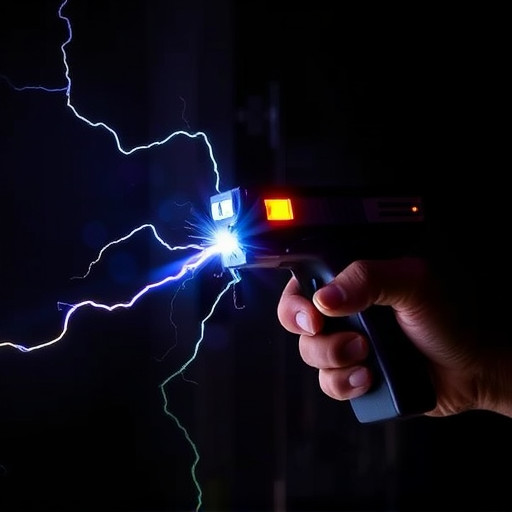The "good" stun gun voltage depends on a balance between power and safety, with 10,000-15,000 volts generally recommended for self-defense. While 50,000 volts or higher can be effective against multiple attackers or strong individuals, it requires careful consideration to avoid excessive harm. Factors like design, target's attributes, and environmental conditions also impact stun gun effectiveness. Responsible usage involves training, targeting vulnerable areas, and understanding local laws regarding stun guns.
“Uncovering the optimal voltage for stun guns is crucial for effective self-defense. With modern devices ranging from 10,000 to 50,000 volts or more, understanding how these weapons function and their real-world impact is essential.
This article delves into the mechanics of stun guns, exploring the role of voltage in incapacitating an assailant. We’ll dissect the implications of 50,000 volts, considering its sources and whether it’s sufficient for self-defense scenarios. Additionally, we’ll emphasize responsible usage through safety guidelines.”
(Keywords: “good stun gun voltage”)
Understanding Stun Guns: How They Work and Their Purpose
Stun guns, also known as electronic control devices (ECDs), are non-lethal weapons designed to temporarily incapacitate a target through muscle confusion and pain. They work by delivering a strong electrical pulse that disrupts the nervous system’s ability to transmit signals to muscles, causing them to contract uncontrollably. This results in a brief loss of balance, disorientation, and, in some cases, paralysis for several minutes.
The purpose of a stun gun is not to kill but to disable an assailant long enough for the victim to escape or for help to arrive. The effectiveness of a stun gun depends on several factors, including the device’s voltage output. A good stun gun voltage is typically between 5,000 and 15,000 volts, as this range ensures sufficient power to overcome an attacker’s resistance while minimizing the risk of serious injury. For self-defense purposes, a stun gun with a voltage of 50,000 volts or more can be considered powerful enough to achieve these objectives effectively.
The Role of Voltage: What is a Safe and Effective Level?
The effectiveness of a stun gun largely depends on its voltage output, a key factor in delivering a powerful and safe shock. But what constitutes a good stun gun voltage? It’s not as simple as choosing a higher number; safety and efficacy must go hand in hand. Generally, voltages between 10,000 to 15,000 volts are considered sufficient for neutralizing an aggressor temporarily, with 50,000 volts being at the upper end of this spectrum. However, it’s crucial to remember that higher voltage doesn’t always equate to better performance; factors like current and pulse width also play significant roles in the stun gun’s impact.
A good stun gun should strike a balance between delivering a strong shock capable of incapacitating an assailant and ensuring user safety through minimal risk of permanent injury. While 50,000 volts might be potent, it’s not inherently the ideal; a stun gun with a lower voltage but precise current delivery could prove more effective in achieving the goal of self-defense while minimizing the potential for harm to the user or bystanders. When considering what is a good stun gun voltage, focusing on these broader factors rather than just the number ensures a safer and more reliable choice.
50,000 Volts Deconstructed: Sources and Implications
A stun gun’s effectiveness largely depends on its voltage, and 50,000 volts is a significant figure in this context. This high voltage is achieved through a combination of powerful capacitors and advanced electrical engineering. Such a robust design ensures the stun gun delivers an intense electric shock capable of temporarily incapacitating an opponent.
When considering what is a good stun gun voltage, 50,000 volts stands out as a benchmark. This voltage is not only sufficient to stop an aggressor but also provides users with a margin of safety. It’s important to note that while 50,000 volts can be effective, the actual impact varies based on factors like the stun gun’s design, the target’s physical attributes, and environmental conditions.
Real-World Applications: Is This Voltage Enough for Self-Defense?
In real-world applications, the effectiveness of a stun gun largely depends on its voltage. When considering whether 50,000 volts is enough for self-defense, it’s important to understand that this high voltage is designed to disrupt an attacker’s nervous system temporarily, rendering them immobile. Studies show that stun guns with voltages ranging from 10,000 to 15,000 volts are generally considered powerful enough for personal defense against a single aggressor. However, for situations involving multiple attackers or more robust individuals, higher voltages like 50,000 can provide an additional margin of safety.
The concept of “what is a good stun gun voltage” varies based on individual needs and local legal restrictions. While 50,000 volts may be sufficient for some, others might prefer lower voltages to minimize the risk of causing serious harm or accidental discharge. Ultimately, choosing the right voltage depends on factors like intended use, physical capabilities, and jurisdiction.
Safety Considerations: Using Stun Guns Responsibly at Such High Voltages
When considering the safety implications of using a stun gun with 50,000 volts, it’s crucial to understand that while this high voltage can cause severe discomfort and temporarily incapacitate a target, it also demands responsible usage. The concept of what constitutes a “good” stun gun voltage is multifaceted; it should be enough to effectively deter an attacker without causing excessive harm or long-term injury.
Responsibly using a stun device at such high voltages involves adhering to strict safety protocols. Users must ensure proper training, as misusing this level of electrical power can have severe consequences. It’s essential to target specific vulnerable areas, like pressure points and nerve centers, to minimize damage while maximizing the stun’s effectiveness. Additionally, regular maintenance and understanding of local laws regarding stun gun ownership and use are vital for responsible and legal deployment.
